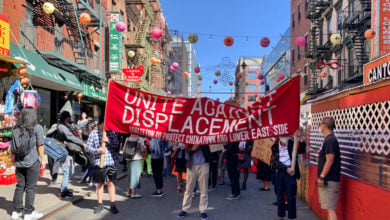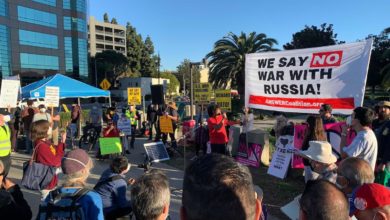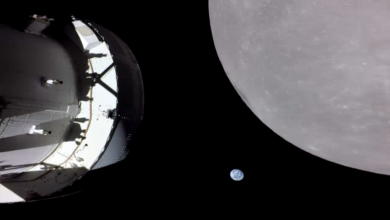 Military spending and production for World War II stimulated the U.S. economy. |
Those years, however, included the full scale U.S. mobilization for World War II—the largest and bloodiest war ever.
The Pentagon now has more than 750 military bases in 130 countries. There are more than 2 million U.S. soldiers in uniform. In the federal budget, war spending accounts for more than 50 percent of all discretionary spending. (New York Times, Feb. 8, 2005)
A recent survey conducted by the Program for International Policy Alternatives revealed that 65 percent of the public favored cutting “defense” funding. Increasingly, the demand is heard at demonstrations, rallies and picket lines: Tax dollars should be used for schools, health care, housing and other badly needed, under-funded programs. This is a progressive trend that reflects the deep-seated and unmet needs of working-class communities throughout the country.
A central question for the millions of people who have taken to the streets in recent years to protest war is can the capitalist system reverse the trend toward militarism? Is militarism a policy choice or an organic and fundamental feature of the contemporary U.S. social and economic order?
Before World War II, there was no permanent war machine. The budget for the U.S. War Department (a more apt name than the current Defense Department) was relatively modest. In the decade prior to the 1941 entrance of the United States into the war, the world capitalist economy experienced the greatest economic contraction and stagnation in the history of modern capitalism.
Starting with the 1929 U.S. stock market crash, all countries in the world capitalist economy suffered depression, stagnation and massive unemployment. In 1929, military spending constituted less than 1 percent of the U.S. gross domestic product. The so-called magic of the “free market” led only to economic paralysis and unemployment. Roosevelt spent massive amounts of money on the famed New Deal and government funded “works programs.” Contrary to popular mystique and legend, these civilian-based programs did not bring capitalism to life again. By the end of 1939, official unemployment was still over 17 percent.
Before the passage of the New Deal legislation that created Social Security, unemployment insurance, welfare and a myriad of other government programs, there was no pretense that government had a responsibility to provide for the needs of the working class, the unemployed or those in poverty. Between 1929 and 1939, capitalist economic paralysis was accompanied by a rising tide of labor militancy and the rebirth of a large-scale communist movement inside the United States. General strikes swept San Francisco, Toledo and Minneapolis in 1934. In the next few years, more than 1,000 factories were seized during sit-down strikes.
The government, under the twin threat of labor militancy and the inability of the “free market” to come back to life on its own, intervened by increasing government spending by 70 percent between 1929 and 1939. Yet this liberal strategy, often revived as the solution to the problem of poverty and unemployment, had a negligible impact. Unemployment actually began to sharply increase again in 1938.
While government spending on civilian programs had reached record levels between 1929 and 1939, the level of military spending increased only modestly. Military expenditures, which accounted for 0.7 percent of GDP in 1929, increased only to 1.4 percent of GDP in 1939.
The picture changed dramatically for capitalism only with the advent of global war and global war production. Unemployment in the United States dropped from its pre-war level of 17 percent to 1.2 percent in 1944.
World war rescued capitalism
What saved capitalism from the massive economic devastation of the Great Depression? Only the social and human devastation of most of Europe and large parts of Asia during World War II.
On the one hand, surplus means of production as well as surplus commodities were destroyed in the war, setting the stage for a new capital expansion after the war. On the other hand, military spending during the war itself—especially in the United States—mobilized millions of people into the workforce and brought auto, steel, rubber, aerospace, transportation and mining industries back to life.
War production resuscitated industry in the capitalist countries, whether they were led by fascist politicians in Germany or “democrats” in the United States and Britain. State intervention in the form of military spending and military production absorbed additional surplus capital that had caused overproduction and depression.
“The Great Depression of the 1930s never came to an end. It merely disappeared into the great [war] mobilization of the forties,” admitted John Kenneth Galbraith. Galbraith was among the most famed of the liberal economists who advocated non-military government spending as the antidote to the inherent problem of capitalist overproduction. These economists believed that the government intervention in the capitalist economy could abolish, or at least lessen, the negative features of capitalist crisis and depression. Government spending on public sector goods and services, the story went, could save capitalism from itself.
Boosting government spending, the liberals argued, would raise the purchasing power and consumption level of the people, offsetting the undeniable trend toward overproduction in unfettered free-market capitalism.
The worldwide depression of the 1930s was not overcome by the traditional “boom-bust cycle” inherent to capitalism. Nor was the moribund economy jump-started through the stimulation provided by Keynesian government-spending programs. It was World War II and the accompanying surge of state-sponsored militarism that was decisive.
Since the end of World War II, the capitalist “boom-bust cycle” of economic expansion, recession and economic recovery has continued. There has not yet been a repeat of a generalized worldwide depression and paralysis of the magnitude of the 1930s.
Following World War II, a high degree of consensus emerged inside the capitalist economic establishment and among almost the entire cast of politicians in both the Democratic and Republican Parties that militarism—indispensable in the struggle against socialism and national liberation movements around the world—was the best bet to prevent a return to capitalist stagnation and depression.
While military spending equaled only 1.4 percent of the GDP in 1939, the number stayed between 5 and 13 percent in the 1950s with the advent of what Dwight Eisenhower dubbed the permanent “military-industrial complex” in his famous “Farewell Address” in 1960.
The actual percentage of the gross domestic product that military spending constitutes in 2005 varies, depending on who is doing the counting. But in today’s vastly expanded economy, even 5 percent of the GDP constitutes a central pillar of resource allocation.
 Photo: PR News Photo |
Contemporary U.S. militarism, or the permanent Military-Industrial Complex, took shape at the beginning of World War II. First developed as a response to the immediate exigencies of a looming war, it became a stable and permanent feature of the economic and political system in the 1940s and 1950s, whether the country was at war or “at peace.”
This reality has generated wide debate among Marxist and progressive economists. Marx himself did not confront the phenomenon of a massive-scale military-industrial complex in his lifetime.
Some, like Paul Sweezy and Paul Baran, said that the war economy was a necessary stimulant for the capitalist economy. Without it, U.S. capitalism would quickly slip back into a 1930s style depression. This argument, spelled out in their 1966 book Monopoly Capitalism, also maintained that militarism could not save U.S. capitalism from crisis and degeneration.
Others, like liberal economist Seymour Melman and Marxist sociologist Albert Szymanski, argued that U.S. capitalism was actually harmed by the military-industrial complex. “Because of its economically parasitic nature—yielding products that are neither for consumption nor for further production—a military economy … [through its] enormous and wasteful investment had led to America’s decline as an industrial power and to the stagnation of the once powerful economy,” Melman wrote in his 1974 book, The Permanent War Economy.
Still others emphasized the two-fold and contradictory character of the permanent war economy, which acts as a both an economic stimulus and as a depressant. Marxist leader Sam Marcy compared contemporary militarism to drug addiction—an artificial stimulant that over time becomes its opposite. As U.S. industrial power slipped in the 1970s relative to the German and Japanese capitalist economies, Marcy noted that it was precisely the limitations on the development of their armed forces that allowed Germany and Japan to focus resources on developing their civilian goods sectors.
Militarism and massive military spending are essential and dominant features of U.S. society. To the extent that the permanent war economy has functioned as a stabilizer in the post World War II decades, U.S. capitalism, as an integral part of the global capitalist economy, is still vulnerable to economic contraction and crisis of the same or larger magnitude as the Great Depression of the 1930s. The massive national debt, balance of trade deficit, the weakened dollar and the continued trend toward de-industrialization are an explosive mix as the world economy moves toward the next shock resulting from the “boom-bust cycle.”
Military spending, to the extent that it is an economic stimulus, has certain unique features. Take the $3.2 trillion that will be spent between 2001 and 2008. This money goes to privately owned corporations to produce goods and services that do not compete with other commodities seeking buyers in the capitalist “free market.” Every warplane, tank, cruise missile and piece of equipment in the so-called missile defense system is ultimately paid for by the government. So is the steel, rubber, plastics and other core commodities that are used in their manufacture.
Military commodities will not circulate. They will not be used for anything until it is time to destroy and be destroyed in a military conflict. They cannot be overproduced because they are not competing to be sold on the market. There is no real capitalist competition; the risk has been removed. The Pentagon guarantees that all costs will be recovered. Often, corporate profits are contractually based on a fixed percentage of the costs of production.
The capitalist competing for the civilian goods and services market is constantly trying to lower costs in order to beat out the competition—barring such things as monopoly pricing. The capitalist producing for the Pentagon has an interest in increasing the costs of production. This capitalist is guaranteed profit equal to something like 6 or 8 percent of the costs of production. This gives rise to the infamous $600 toilet seat, $250 hammer and thousands of other instances of inflated costs and cost overruns.
The political domination of the Pentagon over Congress is commensurate with the pivotal role played by militarism in the modern U.S. economy. But its economic role is only one part of understanding the centrality of militarism in the fortunes of the U.S. capitalist class. The far-flung and ever expanding military buildup conforms to the strategic needs of the U.S. ruling class as it establishes, maintains and enforces a world empire.
 Control of the world’s main oil supply is central to U.S. aims. |
From 1945 to 1991, the Pentagon was the primary institution organized to stem the tide of socialism as it spread from one part of the globe to every continent. In the misnamed “Cold War,” U.S. imperialism was the vanguard of a global counteroffensive against the Soviet Union, other socialist governments and national liberation movements in Asia, Latin America, the Middle East and Africa.
Today, the Soviet Union and the socialist camp have been destroyed. This has intensified rather than softened U.S. big business’ drive toward world domination.
The compelling desire to control the world’s oil and energy supply is pivotal to the Pentagon and Wall Street’s strategic thinking. The invasions of Afghanistan and Iraq are just the tip of the iceberg. Every former Soviet Socialist Republic in the Caucuses and Central Asia is a target for takeover. The Pentagon has recently announced the spending of $100 million to build what it calls the Caspian Guard, a network of police forces and special operations units in Baku (the former center of the Soviet oil industry) and the rest of the Caspian region.
Nigeria, Angola, Gabon, Sudan and other oil rich African counties, not to mention Venezuela and Indonesia, are the focus of diplomatic and military planning.
Like all empires in history, military might is an essential prerequisite. Many commentators, both mainstream and progressive, have analyzed U.S. global strategy and its current doctrine of pre-emptive, “endless” war.
It is also important, as the working-class and anti-war movements mobilize against and expose imperialism, to unmask the brutal reality that modern-day capitalism is incapable of reversing the trend toward militarism. The “free market” is a myth. The capitalist class employs state intervention—in the form of the most destructive militarism—as both a necessary cost to maintain its global empire and an attempt to stave off economic crises.
Marx described capitalism at the dawn of its existence as a system that came into the world with blood dripping from every pore. He was referring to the role of the African slave trade, the genocide of Indigenous peoples in the Americas and the colonial enslavement of whole peoples as the precondition for the original accumulation of capital.
Now, in capitalism’s late stage of existence as a social system, Marx’s graphic description has lost none of its poignancy or accuracy.






